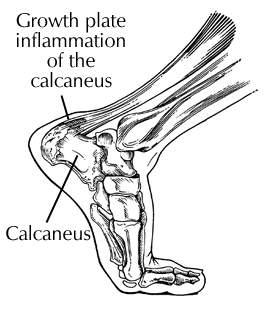In one study of injuries among players aged 9-19 years in football academies, 2% of overall football injuries were due to Sever’s disease. The peak for incidence was in the under-11 age group. In a study of 85 children, 61% of children had pain in both heels.
- Sever’s disease is a condition that affects growing children who exercise. It is caused by the pulling of the Achilles tendon on the growth plate in the heel bone (a traction apophysitis is the medical name for this condition).
- This causes inflammation of the growth plate in the heel bone (calcaneus) and in the Achilles tendon. There may be tenderness and occasionally swelling over the heel.
- Sever’s disease is more common in boys than girls; it is most common in very active children between the ages of 9 and 13.
- Pain can be in one or both heels. The pain is usually less when resting.

Factors contributing to Sever’s disease include:
- Rapid growth and high levels of activity, particularly running and jumping activities.
- Tightness and poor flexibility in the muscles at the back of the legs (hamstrings and calf muscles).
- Stiffness in the back and buttock muscles.
- Shoes that pressure or rub on the heel.
- Biomechanical factors like flat feet.
Treatment for Sever’s disease focuses on reducing pain and swelling. This typically requires limiting exercise activity until players can enjoy activity without pain during or significant pain after training or playing.
In some cases, rest from sports is required for several months, followed by a strength and conditioning program. However, if your child does not have a large amount of pain or a limp, participation in sports may be safe to continue.
Early assessment and treatment from our physiotherapists can usually result in less missed time from training and playing.
Please note: this information should serve as a guide only. When in doubt always seek advice from Southside Physiotherapy & Sports Injury Centre or your GP.
